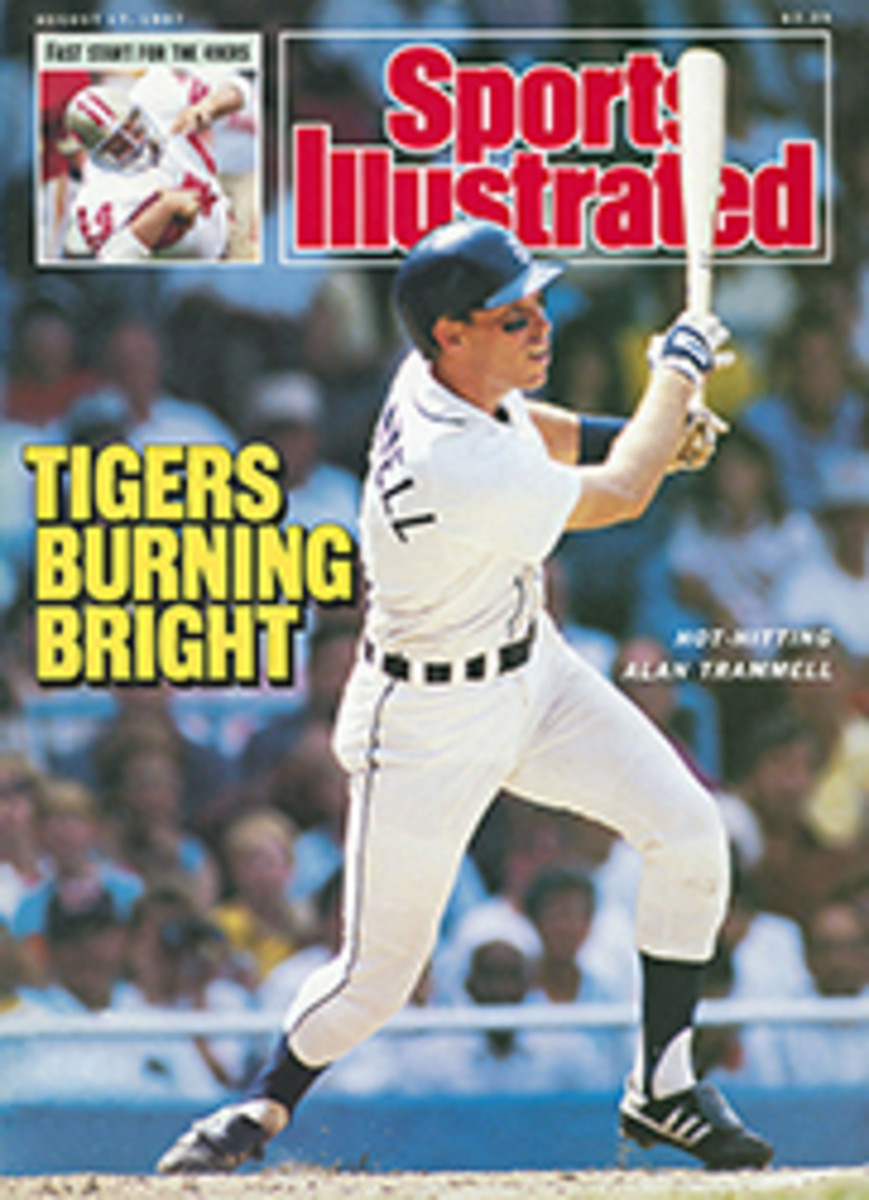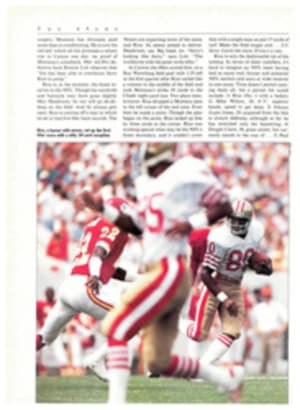
THE WALL WENT UP AND THE A'S CAME TUMBLING DOWN
Do you like baseball the way it is played at Fenway Park, with the Green Monster looming behind every pitch? If you do, then you would have loved Philadelphia's Shibe Park some 60 years ago. There, out in rightfield, was the most controversial fence in baseball.
When Shibe Park, home of Connie Mack's world-renowned Philadelphia Athletics, opened on April 12, 1909, the distance down the rightfield foul line was 360 feet. And in that era of the dead baseball, rarely did the ball travel that far. (Pick up a bat sometime and try to hit a croquet ball that distance in the air. Then you'll have the idea.) Indeed, the coziest aspect of the Shibe Park "wall" was its height: 12 feet. It was high enough to block the view of passersby and just far enough from the plate to keep most long drives inside the ballpark. But from the second-story windows and the rooftops of the houses across North 20th Street, spectators had a perfect view of all the A's home games. Therein lies the story.
By the 1920s, Shibe's grandstands had been rebuilt and home plate relocated. The distance down the rightfield line was now 329 feet. And by then, the game of baseball had changed. The cork-centered ball was in use, trick pitches like the spitter were banned, and the big lefthanded hitters of the day—notably Babe Ruth and Lou Gehrig—spent many afternoons blasting baseballs at friendly fences in Shibe and a few other parks. The results were dramatic: In 1918, the last-place A's led the league in home runs with 22. Four years later, the seventh-place A's led with 111 home runs, thanks to the 12-foot wall.
Roger (Doc) Cramer, 82, of Beach Haven, N.J., recalls the rightfield situation well. Cramer played in 2,239 American League games between 1929 and 1948, and for four years he was Mack's regular centerfielder.
"It was a bad wall to play," he says. "It had concrete sticking out and would stop you right quick if you ran into it. Worse, there were no caroms. The ball would drop straight down."
Edwin (Dib) Williams, 77, a regular infielder for Mack during the glory days, recently recalled another feature of the wall. It brought people into the game. Literally. "Kids on North 20th Street," Williams says from his home in Greenbrier, Ark., "used to shove ladders up against the other side, scale the wall and disappear into the grandstands." During games, other kids would sit on top of the wall and no one bothered them.
Some of the players also liked the wall. Mule Haas and Mickey Cochrane hit directly at it. Al Simmons and Jimmie Foxx, righthanded batters, were so strong that they could easily target an outside pitch for North 20th Street. Obviously, it was an interesting block on which to live.
"I saw Foxx hit balls into the windows across the street," Williams remembers, "and I saw Ruth hit them over the rooftops." This was powerhouse baseball. Balls would crash down in this otherwise peaceful North Philadelphia neighborhood dozens of times each week. But in the entrepreneurial spirit of the day, the frequent sound of a baseball crashing against a front porch or bedroom wall was not a nuisance; it was the sound of opportunity knocking.
"Admission to the bleachers at Shibe Park was 50 cents when I was a boy," recalls John J. Rooney, 64, now a professor at La Salle University in Philadelphia. "But at our house and on our rooftop, where we had a perfect view of the field, the price was only a quarter."
Rooney's family was one of many along North 20th Street that went into business. Anything from dining-room chairs to crates was placed on the rooftops for the paying customers. For the big games with the Yankees, when the 33,608 seats in Shibe Park were sold out, the price of admission was as much as half a dollar. The rooftop business might seem like a nickel-and-dime enterprise, but the A's played 77 home games a year and that made for a lot of change.
Then came 1929. The A's had their greatest season ever, finishing 18 games in front of the second-place Yankees. Seats on the rooftops sold briskly. On Oct. 14, Haas dropped a lazy two-run, ninth-inning homer over the rightfield wall to tie the fifth game of the World Series against the Chicago Cubs. Simmons doubled off the adjacent scoreboard. Foxx was walked intentionally. Bing Miller doubled off the same scoreboard, and the A's won 3-2 and took the Series four games to one. Sensing the birth of a dynasty, the homeowners across the street erected bleachers—that's right, bleachers—on their rooftops for the following season.
The A's repeated as world champions in 1930 and won the pennant in 1931. Rooftop business was booming, despite the Depression, fire inspectors who went door-to-door suggesting that rooftop seating was a fire hazard and city tax collectors who maintained that the seating created a "place of public amusement." Greasing a few palms solved the problems. But there was another cloud on the horizon, a man by the name of John Shibe, part owner (along with his brother, Tom, and Connie Mack) of both the team and the ballpark.
"John Shibe liked to yell a lot," recalls Cramer. "He didn't even like you to walk on the grass behind home plate during batting practice. Didn't want you cutting his turf with your spikes. Oh, he'd holler at you."
Imagine how a man who didn't want his champion players walking on his grass would react to people scaling his fence with ladders, sitting in someone else's bleachers and even eating hot dogs ("We'd buy them from street vendors for a nickel and sell them on the rooftops for a dime," says Rooney) without his getting a piece of the action. Shibe was furious. In 1932 he decided to act.
At first he proceeded cautiously. After all, the A's had deep roots in the community. Williams still remembers rooming at Mrs. Truitt's boardinghouse across the street from the park. Several other players took their meals there. Simmons rented a room on the North 20th Street block, stayed in it a few seasons, then continued to pay for it after he was a star and had moved to a downtown hotel. "Simmons was superstitious and didn't want to break his good luck," Williams recalls.
Unfortunately, it was the team that started to run out of luck. The A's were second in the American League in 1932 and third in 1933. Despite some excitement at Shibe (Gehrig's four-home run game and Foxx's 58-homer season in 1932), the A's were obviously slipping. They hit the second division in 1934.
Community relations weren't exactly leading the league, either. The homeowners on North 20th, pleading free enterprise, refused Shibe's suggestion that they open the rooftops only when the ballpark was full. So, during the winter of 1934-35, carpenters and ironworkers were called to Shibe Park. Up went a huge expanse of corrugated metal that added 38 feet to the existing 12-foot fence, completely blocking the view from across the street. It was a jolting thing to see, a blight on the landscape. "We came back from spring training and there it was," Cramer remembers.
"We were out of business on Opening Day, 1935," recalls Rooney. A series of unsuccessful lawsuits followed, and eventually the rooftop bleachers were taken down.
The great Philadelphia Athletics also came down. In various deals, Cochrane, Cramer, Jimmy Dykes, Foxx, Lefty Grove, Haas, Miller, Simmons and Williams were traded off, mostly for cash and warm bodies. The A's hit the basement in 1935 and stayed there.
The wall itself became a symbol of the team's collapse. Dubbed "the spite fence," the monstrous new wall shielded from public view a team that no one wanted to see. As it turned out, the new wall was permanent but the fans were not. Free to come and go, most of the fans went. The A's stayed on at Shibe for another 19 painful seasons, playing before vast sections of empty grandstands. The fans, like the bleachers across the street, never came back.
ILLUSTRATION
TERRY WIDENER
Noel Hynd, who lives in Philadelphia, writes frequently about old-time baseball.

